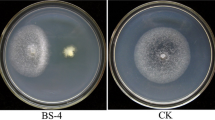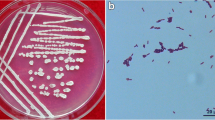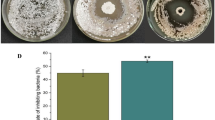Abstract
Biocontrol agents have not been previously associated with yak dung. We describe here the isolation of strain QM3 from Qinghai yak dung in China. In vitro antagonistic assay showed that this strain could suppress the growth of various plant pathogens effectively, especially the pathogen Alternaria solani. Based on phenotypic, physiological, biochemical and phylogenetic (16S rDNA) studies, strain QM3 could be classified as a strain of Bacillus subtilis. Both OD660 and inhibition effect of eight different kinds of culture media presented strongly significant difference with 0.006 (P < 0.01) and 0.003 (P < 0.01), respectively. Culture media YPF-Ca were selected from eight different kinds of culture media according to OD660 and inhibitory effect. Different thermal treatments on the crude supernatant showed the antibiotic activity presented no significant (P = 0.54, P > 0.05) with ANOVA at the 5% level when temperature was no higher than 100°C. These results were similarly in agreement with the reported thermo-resistance of iturin antibiotics produced by Bacillus. This is the first report on the isolation of Bacillus subtilis from the yak dung.




Similar content being viewed by others
References
Bagnasco P, De La Fuente L, Gualtieri G, Noya F, Arias A (1998) Fluorescent Pseudomonas spp. as biocontrol agents against forage legume root pathogenic fungi. Soil Biol Biochem 30:1317–1322. doi:10.1016/S0038-0717(98)00003-0
Bais HP, Fall R, Vivanco JM (2004) Biocontrol of Bacillus subtilis against infection of Arabidopsis roots by Pseudomonas syringae is facilitated by biofilm formation and surfactin production. Plant Physiol 134:307–319. doi:10.1104/pp.103.028712
Bernal G, Illanes A, Ciampi L (2002) Isolation and partial purification of a metabolite from a mutant strain of Bacillus sp. with antibiotic activity against plant pathogenic agents. Electron. J Biotechnol 5:21–28
Besson F, Michel G (1991) Influence of divalent ions on the solubility of iturin and bacillomycin L, antifungal peptidolipids of Bacillus subtilis. Microbios 65:15–21
Besson F, Chevanet C, Michel G (1987) Influence of the culture medium on the production of iturin A by Bacillus subtilis. J Gen Microbiol 133:767–772
Compant S, Duffy B, Nowak J, Clément C, Barka EA (2005) Use of plant growth-promoting bacteria for biocontrol of plant diseases: principles, mechanisms of action, and future prospects. Appl Environ Microbiol 71:4951–4959. doi:10.1128/AEM.71.9.4951-4959.2005
Fani R, Bandi C, Bazzicalupo M, Ceccherini MT, Fancelli S, Gallori E, Gerace L, Grifoni A, Miclaus N, Damiani G (1995) Phylogeny of the genus Azospirilllum based on 16S rDNA sequence. FEMS Microbiol Lett 129:195–200
Fisher SH, Sonenshein AL (1991) Control of carbon and nitrogen metabolism in Bacillus subtilis. Annu Rev Microbiol 45:107–135. doi:10.1146/annurev.mi.45.100191.000543
Gerhardt P, Murray RGE, Wood Willis A, Krieg Noel R (1994) Methods for general and molecular bacteriology. American Society for Microbiology, Washington DC. ISBN: 1555810489
Gong CM (2007) Microbial safety control of compost material with cow dung by heat treatment. J Environ Sci (China) 19:1014–1019. doi:10.1016/S1001-0742(07)60164-8
Han J, Sun L, Dong X, Cai Z, Sun X, Yang H, Wang Y, Song W (2005) Characterization of a novel plant growth-promoting bacteria strain Delftia tsuruhatensis HR4 both as a diazotroph and a potential biocontrol agent against various plant pathogens. Syst Appl Microbiol 28:66–76. doi:10.1016/j.syapm.2004.09.003
Maget-Dana R, Peypoux F (1994) Iturins, a special class of pore-forming lipopeptides: biological and physicochemical properties. Toxicology 87:151–174. doi:10.1016/0300-483X(94)90159-7
Matsusaki H, Endo N, Sonomoto K, Ishizaki A (1996) Lantibiotic nisin Z fermentative production by Lactococcus lactis IO-1: relationship between production of the lantibiotic and lactate and cell growth. Appl Microbiol Biotechnol 45:36–40. doi:10.1007/s002530050645
Ouoba LI, Diawara B, Amoa-Awua W, Traoré AS, Møller PL (2004) Genotyping of starter cultures of Bacillus subtilis and Bacillus pumilus for fermentation of African locust bean (Parkia biglobosa) to produce Soumbala. Int J Food Microbiol 90:197–205. doi:10.1016/S0168-1605(03)00302-7
Shoda M (2000) Bacterial control of plant diseases. J Biosci Bioeng 89:515–521. doi:10.1016/S1389-1723(00)80049-3
Stanier RY, Palleroni NJ, Doudoroff M (1966) The aerobic Pseudomonads: a taxonomic study. J Gen Microbiol 43:159–271
Yang CF, Lee CM (2007) Enrichment, isolation, and characterization of phenol-degrading Pseudomonas resinovorans strain P-1 and Brevibacillus sp. strain P-6. Int Biodeterior Biodegradation 59:206–210. doi:10.1016/j.ibiod.2006.09.010
Acknowledgements
We thank Prof. Y.Q. Zhang, Dean of Biotechnology Center, School of Pharmacy, the Fourth Military Medical University, Xi’an, China, for his valuable permission to assay identification of strain, Dr. X.C. Xue, Biotechnology Center, School of Pharmacy, the Fourth Military Medical University, Xi’an, China, for his constructive advice on molecular assays and Prof. H.Q. Yu, School of Chemistry, University of Science and Technology of China, Hefei, China, for his kindly and critical suggestions on manuscript preparation. This work was supported by Project of the Natural Science Foundation for Young Scientists of Shanxi Province, China (2008021040) and Project of the Natural Science Foundation of Shanxi Normal University (YZ07013), and partially supported by Program of Ministry of Education of China for New Century Excellent Talents in University (NCET-05-0831).
Author information
Authors and Affiliations
Corresponding author
Rights and permissions
About this article
Cite this article
Hu, QP., Xu, JG., Song, P. et al. Isolation and identification of a potential biocontrol agent Bacillus subtilis QM3 from Qinghai yak dung in China. World J Microbiol Biotechnol 24, 2451–2458 (2008). https://doi.org/10.1007/s11274-008-9767-6
Received:
Accepted:
Published:
Issue Date:
DOI: https://doi.org/10.1007/s11274-008-9767-6




